
About UsThe Numismatic Bibliomania Society is a non-profit organization devoted to the study and enjoyment of numismatic literature. For more information please see our web site at coinbooks.org SubscriptionsThose wishing to become new E-Sylum subscribers (or wishing to Unsubscribe) can go to the following web page link MembershipThere is a membership application available on the web site Membership Application To join, print the application and return it with your check to the address printed on the application. Membership is only $20 to addresses in the U.S., $25 for First Class mail, and $30 elsewhere. For those without web access, write to: David M. Sundman, Treasurer
AsylumFor Asylum mailing address changes and other membership questions, contact David at this email address: dsundman@LittletonCoin.com SubmissionsTo submit items for publication in The E-Sylum, just Reply to this message, or write to the Editor at this address: whomren@gmail.com BUY THE BOOK BEFORE THE COINSale Calendar |
- WAYNE'S WORDS: THE E-SYLUM MAY 17, 2015
- NEW BOOK: MARYLAND PAPER MONEY
- NEW BOOK: ROYAL COMMEMORATIVE MEDALS 1837-1977. V3
- NEW BOOK: 17TH CENTURY TRADING TOKENS OF SURREY AND SOUTHWARK
- NEW BOOK: COINAGE AND HISTORY OF WODEYARS OF MYSORE
- BOOK REVIEW: THE COINS OF FORT ATKINSON
- BOOK REVIEW: ROMAN COINS ‘MILLENIUM EDITION’ VOL 5
- ANS CANCELS 'NUMISMATIC LITERATURE' #150
- DIANE PIRET, 1947-2015
- SUBSCRIBER PROFILE: JOSEPH ESPOSITO
- NOTES FROM E-SYLUM READERS: MAY 17, 2015
- THE ARCHER M. HUNTINGTON MEDAL
- QUERY: COL HARDY CRIER TOKEN ODD DENOMINATION
- SOME INTERESTING TOKENS FROM BALDWIN'S: MAY 15, 2015
- HARRIET TUBMAN RECOMMENDED FOR THE U.S $20 NOTE
- EARL & KOEHLER LINCOLN CENT COIN BOARD SURFACES
- MORE ON U.S. MINT CLIPPINGS RECEIPTS
- 1941 PANAMA 'ARIAS' CURRENCY ISSUE
- 2014 IBNS BANK NOTE OF THE YEAR NOMINEES
- STARVING LIBERTY ZOMBUCKS
- THE WISCONSIN TOKEN COLLECTION
- THE ALL-IRELAND HURLING MEDAL
- DOUBLE COIN LIBERTY SEATED LOVE TOKEN
- WAYNE’S NUMISMATIC DIARY: MAY 17, 2015
- 1793 CENT FLOWN ON GEMINI VII SPACECRAFT
- ROMAN COIN HOARD FOUND IN READING
- COINS OF TWO REALMS: THE ARAB COIN SYSTEM
- 1952 ‘GERMANISCHES MUSEUM’ COMMEMORATIVE COIN
- DOWNIE'S TO SELL AUSTRALIAN MASTER COINS
- THE BEGINNING OF THE END OF CURRENCY AND COINS?
- BEWARE! BOOKS ARE DANGEROUS
- FEATURED WEB SITE: THE SILVER STRIKERS CLUB
Click here to access the complete archive
To comment or submit articles, reply to whomren@gmail.com
WAYNE'S WORDS: THE E-SYLUM MAY 17, 2015

New subscribers this week include: Charles Farthing, courtesy of David Powell, Martin H Gagern, John Lorenzo, and Richard Ashton. Welcome aboard! We now have 1,858 subscribers.
This week we open with two new books, two book updates, and two reviews. Other topics include the Archer M. Huntington medal, coin boards, Wisconsin tokens, an unusual Liberty Seated Love Token, and the Arab coin system.
To learn more about Numismatic Literature, Diane Piret, the 1874 Trinidad Farthing, a VERY odd denomination token, Zombucks, Cowbucks, Silver Strikers, Master coins, banana tokens, hurling medals, Cubist medals and Logistical Exercise scrip, read on. Have a great week, everyone!
Wayne Homren
Editor, The E-Sylum
NEW BOOK: MARYLAND PAPER MONEY
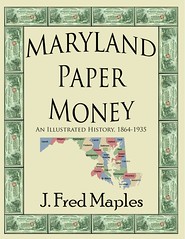 Maryland Paper Money: An Illustrated History, 1864-1935
Maryland Paper Money: An Illustrated History, 1864-1935
By Fred Maples
Hardcover, 358 Pages
Price: $46.00
Ships in 6-8 business days.
This non-fiction book documents the history of Maryland's national currency era from 1864 to 1935, and illustrates the beautiful currency in detail. The currency was issued by 138 Maryland banks from Friendsville in the west to Berlin in the east. While national currency notes were issued by individual banks, they were federal paper money and circulated across all states and territories.
Research for this book required hundreds of interviews and thousands of hours, and involved cataloging surviving national currency notes, documenting bank histories, and the lives of the 810 known bank officers who signed the currency. The research pulled extensively from the U.S. National Archives, Smithsonian Institution, Maryland Historical Society, local historical societies, Comptroller of Currency Annual Reports, U.S. census records, newspaper clippings, and family interviews. Almost 300 photos of surviving notes are shown, including many notes from the Marc Watts Collection of National Currency.
Fred adds:
“This book was a labor of love. As I traveled the state to research this material, I enjoyed meeting and talking with hundreds of people along the way. I believe all collectors, not just those from Maryland, and will enjoy reading and learning about the state’s rich history of banks, bankers, and paper money.”
For more information, or to order, see:
www.marylandpapermoney.com and
Maryland Paper
Money: An Illustrated History, 1864-1935
(www.lulu.com/shop/fred-maples/maryland-paper-money-an-illustrated-history-1864-1935/hardcover/product-22136550.html)
NEW BOOK: ROYAL COMMEMORATIVE MEDALS 1837-1977. V3
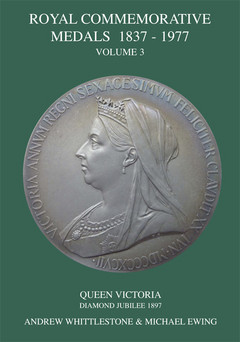 Royal
Commemorative Medals 1837-1977. Vol. 3. Queen Victoria, Diamond Jubilee 1897.
Royal
Commemorative Medals 1837-1977. Vol. 3. Queen Victoria, Diamond Jubilee 1897.
Andrew Whittlestone and the late Michael Ewing. Galata, Llanfyllin. 2nd edition, 2015 PB A4 133 pages NEW
This new, improved and expanded edition 204 x 297mm with glossy laminated cover, is well-illustrated throughout with many hundreds of
high-quality black and white illustrations.
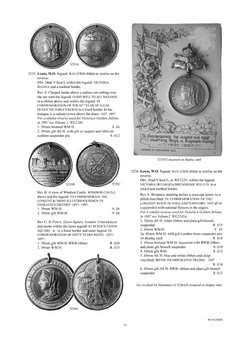 It has indexes
of obverse and reverse legends, makers, designers, die cutters and publishers, and an index of registered design numbers as well as a
general index, so as to make finding a particular medal easy.
It has indexes
of obverse and reverse legends, makers, designers, die cutters and publishers, and an index of registered design numbers as well as a
general index, so as to make finding a particular medal easy.
For more information, or to order, see:
Royal Commemorative Medals 1837-1977. Vol. 3. Queen
Victoria, Diamond Jubilee 1897. (www.galata.co.uk/store.asp?storeAction=showDetail&stockID=7816)
To read the earlier E-Sylum article, see:
NEW BOOK: ROYAL COMMEMORATIVE MEDALS 1837-1977. V3
(www.coinbooks.org/esylum_v18n19a09.html)
NEW BOOK: 17TH CENTURY TRADING TOKENS OF SURREY AND SOUTHWARK
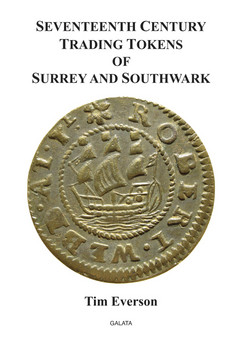 Seventeenth Century Trading Tokens of Surrey and Southwark
Seventeenth Century Trading Tokens of Surrey and Southwark
Tim Everson. Galata. 2015. A4 PB, laminated covers. 129 pages, 1 : 1 colour illustrations throughout. The very latest research on the subject, including 39 pieces not previously catalogued. All tokens that it was possible to photograph have been illustrated.
For more information, or to order, see:
Seventeenth Century Trading Tokens of Surrey and
Southwark (www.galata.co.uk/store.asp?storeAction=showDetail&stockID=7961)
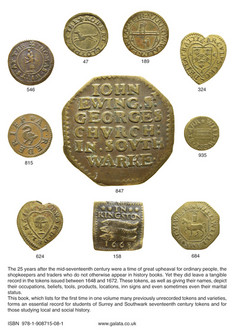
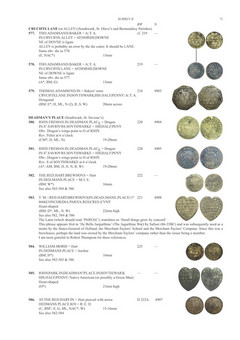
To read the earlier E-Sylum article, see:
NEW BOOK: 17TH CENTURY TOKENS OF SURREY AND SOUTHWARK
(www.coinbooks.org/esylum_v18n19a10.html)

NEW BOOK: COINAGE AND HISTORY OF WODEYARS OF MYSORE
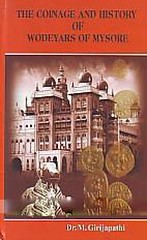 The Coinage and History of Wodeyars of Mysore Authors (s): M. Girijapathi (Author)
The Coinage and History of Wodeyars of Mysore Authors (s): M. Girijapathi (Author)
Format: Hardcover
Pages: 82p., Illustrations; Colour; 23cm.
Pub. date: 31.12.2014, 1st. ed.
Publisher: Varsha Publications
Language (s): English
Bagchee ID: BB93569
List price: US $ 42,00
Bagchee price: US $ 37,80
For more information, or to order, see:
The Coinage and History of Wodeyars of
Mysore (www.bagchee.com/books/BB93569/the-coinage-and-history-of-wodeyars-of-mysore)
BOOK REVIEW: THE COINS OF FORT ATKINSON
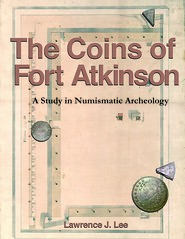 Book Review: The Coins of Fort Atkinson: A Study in Numismatic Archeology
Book Review: The Coins of Fort Atkinson: A Study in Numismatic Archeology
by Dr. Lawrence J. Lee
Fort Atkinson, the westernmost U.S. Army outpost of a westward bound nation, operated from 1819 – 1827 and commands the west bank of the Mississippi River in present day Nebraska. Abandoned in favor of Fort Leavenworth, an undisturbed time capsule of artifacts deposited on the prairie by hundreds of soldiers and fur traders of John Quincy Adams day remained until after ten seasons of archeological excavation, over one hundred coins and coin bits turned up from fort barracks and exchanges with Native Americans and homesteaders on the Santa Fe Trail.
Dr. Lawrence J. Lee, former Director of the American Numismatic Association (ANA) Money Museum in Colorado Springs applies in-depth scientific and numismatic techniques to interpret these fascinating Old West artifacts. Eye witness details from diaries observing life at the fort reveal soldier’s doings as few other archeological digs are so nicely corroborated. For instance
When the weather was nice, the Paymaster would set up several tables outdoors, in bad weather he would use the Paymaster’s Office, housed in “Room 2” in the South Barracks. As each soldiers name was called out by the clerk, the soldier stepped forward, halted and saluted the Paymaster, who returned the salute and counted out in coinage the amount shown as due the soldier on the payroll. The soldier would then count the money to verify the amount, then salute and leave the table. He would next move to the sutler and launderesses tables where accounts were paid from lists of indebtedness in their possession.
The payroll process could take up to two days to work through all the troops. No whiskey could be sold by the camp sutler until the process was complete… The cash to pay the officers and men reportedly included both gold and silver coins, though no gold coins were recovered during excavation. The silver coinage, up to $5000 each month, was composed mostly of freshly minted U.S. Capped Bust Half Dollars. Enlisted men were paid $5.00 (ten half dollars) per month for their services, officers received $10.00 or more, including gold coins, depending on their rank… The payroll specie was transported 150 miles once a month by military escort from Franklin, Missouri… Terminus of the Santa Fe Trail...one of the most important towns in mid-America until it was washed away by a flood of the Missouri River in 1826.
Yet the vast majority of coins excavated were Spanish Colonial silver and cut bits up to a century old, infiltrating the fort from outside the gates from mills, a spring-house, an ice house, a dairy, barns, kilns, black-smith and armorer’s shops and “stores” in tents and wagons of every sort, not to mention bootleggers, road houses and other establishments not approved by the military.
Artifacts are pictured from perpetual calendars to an id disk carved into an 1817 half dollar by Charles. F.L. Durand, 2nd Lt. in the 6th Infantry from 1818 to 1821, a New Yorker, who also carved the name “C. Hamilton” on the reverse of whom we know nothing, but may suspect a romance from back East.
At 70 pages, this is a readable and engaging book unlike most archeological field reports. Loaded with numismatic gems and insights, key-most being that coins are not “trash” as are most archeological recoveries (such as pottery shards, animal bone fragments, pipe stems, and whatnot); but that dug coins must be interpreted with a keen knowledge of forensic numismatics, more a science than a hobby.
To read the earlier E-Sylum article, see:
NEW BOOK: THE COINS OF FORT ATKINSON
(www.coinbooks.org/esylum_v18n10a04.html)
BOOK REVIEW: ROMAN COINS ‘MILLENIUM EDITION’ VOL 5
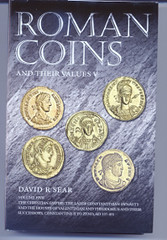 David R. Sear, Roman Coins and Their Values. 'Millenium Edition'. Volume V: The Christian
Empire: The Later Constantinian Dynasty and the Houses of Valentinian and Theodosius and their Successors, Constantine II to Zeno, AD
337-491. Spink, London, 2014. 575 p., black-and-white images throughout. 22.2 x 15 cm. Hardcover. ISBN: 978-1-907427-45-9. 50 GBP.
David R. Sear, Roman Coins and Their Values. 'Millenium Edition'. Volume V: The Christian
Empire: The Later Constantinian Dynasty and the Houses of Valentinian and Theodosius and their Successors, Constantine II to Zeno, AD
337-491. Spink, London, 2014. 575 p., black-and-white images throughout. 22.2 x 15 cm. Hardcover. ISBN: 978-1-907427-45-9. 50 GBP.
In 1964 appeared the first edition of David R. Sear’s one-volume reference book to Roman coins. It was compact and offered a thorough overview of the issues of the Roman Republic and Empire until the end of the fifth century AD. Sear indicated only one price of the coins referring to different conditions according to the metal of the coins. The fourth and last edition of this book of 1988 is still widely popular and currently lies beside me on my desk, too.
At this time the gap to comprehensive corpora like the Roman Imperial Coinage or the older Cohen was, naturally, large and a flaw in the eyes of many ambitious collectors. For that reason by the end of the 1990s David Sear started a new edition, his ‘Millenium Edition’. Originally it was planned to comprise two volumes, but actually it has become a five-volume work whose last volume has just appeared with Spink. This is all the more admirable as many such a large-scale projects (particularly in the scholarly world) are cut in the middle of the way.
Structure and layout of this new edition is analogous to the classical one-volume edition. This seems quite reasonable as the shape has stood the test. The introduction offers collectors information on motifs and dating, mints and denominations, and an alphabetical index allows to quickly find all emperors even those whose exact dates of rule have just slipped one’s memory (a common weakness, particularly when dealing with the quite confusing third century or the Late Antiquity).
Two conspicuous variations from the old Sear are commendable, though. There are no more plates at the end of the book but all images have been included right in the text where the relative coin is dealt with. So, no more turning pages and looking for the correct numbers when checking out a photograph. And then all coins are equally given prices in two conditions: VF (very fine) and EF (extremely fine).
The new, fifth volume alone spanning the time from Constantine’s sons to Zeno and Romulus Augustulus comprises nearly 500 pages of catalogue and almost 4,700 coins! For comparison: the one-volume Sear in the fourth edition offers around 4,300 coins on a bit more than 400 pages for the complete Roman Republic and Empire.
The five volumes are available at Spink’s.
To read the complete article, see:
Sear’s Roman Coins ‘Millenium Edition’ Completed
(www.coinsweekly.com/en/News/4?&id=3429)
ANS CANCELS 'NUMISMATIC LITERATURE' #150
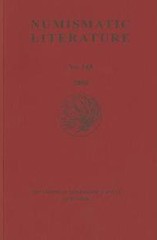 This week, without announcement, the American Numismatic Society decided to cease publication of
Numismatic Literature, its long-running bibliographic journal which began in 1947. A few days ago I received a $50 refund check from
ANS for a prepaid issue which would have been #150, and with it a slip of paper that said:
This week, without announcement, the American Numismatic Society decided to cease publication of
Numismatic Literature, its long-running bibliographic journal which began in 1947. A few days ago I received a $50 refund check from
ANS for a prepaid issue which would have been #150, and with it a slip of paper that said:
"The ANS has recently decided to cancel the publication of Numismatic Literature 150. The last publication was Number 149.
"The attached check is your refund... We apologize for the inconvenience."
The publication was on a quarterly schedule through 1967. From 1968 through 2000, it appeared semiannually. Thereafter, six annual issues appeared, the last dated 2007.
It followed the format of, and considered itself a successor to, the German periodical Numismatisches Literatur-Blatt, started in 1880 by Max von Bahrfeldt who had previously edited a bibliographic supplement to the periodical Numismatisch-sphragistischen Anzeiger. Bahrfeldt’s publication was continued for several years following his death in 1936, then ceased during World War II.
In the first issue of Numismatic Literature, Arthur S. Dewing, then president of ANS, stated that following cessation of NL-B “there has existed nowhere such a single publication that covers” the broad field of world numismatics of all periods of history. NL, he said, “will, in its own way, attempt to provide a journal in which is recorded the literature of numismatics; it will afford a clearing-house for numismatic publications gathered from all over the world.”
Within their fields of expertise, NL’s international editorial staff reviewed newly published books as they came out, as well as hundreds of periodicals worldwide, preparing short annotations to accompany the listings. It also published citations to reviews appearing in other journals, and to obituaries of prominent numismatists.
Cost was probably one factor that brought about the demise of NL. Its price per issue had jumped from around $4.00 in the 1990s to $50.00 at the end. Obsolescence, however, must have been the primary reason, with the growth of research tools on line, including ANS’s own online Donum catalog.
Reviews of numismatic literature by knowledgeable reviewers are invaluable. Let's hope they continue to be written and published. -Editor

DIANE PIRET, 1947-2015
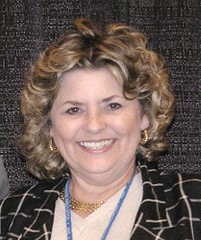 Diane Piret, former ICTA (Industry Council for Tangible Assets) Industry
Affairs Director, passed away April 15, 2015. Diane had a 50 year career in our hobby starting in the rare coin and precious metal business
and continuing as an industry representative working to protect against federal and state laws and regulations harmful to all involved in
numismatics.
Diane Piret, former ICTA (Industry Council for Tangible Assets) Industry
Affairs Director, passed away April 15, 2015. Diane had a 50 year career in our hobby starting in the rare coin and precious metal business
and continuing as an industry representative working to protect against federal and state laws and regulations harmful to all involved in
numismatics.
Diane was a highly respected numismatic industry expert on compliance with the financial reporting aspects of the U.S.A. Patriot Act and she was extremely knowledgeable about a wide variety of numismatics and numismatists. She was a valued resource for numismatic organizations working to prevent onerous state and federal registration and reporting laws and regulations. Likewise she helped numismatic groups attempting to keep laws, such as sales tax exemption, appropriate and realistic. Diane received numerous awards throughout her career, including, the Professional Numismatists Guild’s 2014 Lifetime Achievement Award, the American Numismatic Association’s 2014 Elvira Clain-Stefanelli Memorial Award for Achievement in Numismatics, and the National Silver Dollar Round Table’s 2014 Lifetime Achievement Award.
As ICTA Industry Affairs Director, Diane worked with many organizations in our hobby and with the collector community on a variety of issues related to participating in numismatics. Diane helped the numismatic community convince the TSA to establish rules that permit private screenings of your valued collectibles (so others don’t see what you’re carrying - reducing the risk of a potential robbery) when flying to exhibit, buy or sell your collection. Likewise, Diane helped numismatists convince the FAA to modify rules to allow carrying-on two items of luggage (instead of risking checking and losing your luggage).
Cindy Wibker, FUN Director and Convention Coordinator, commented “She was one of the first people I met and wholeheartedly trusted when I inherited the convention coordinator's job with FUN in 1993. For many years she was my "go to" person when I had specific questions about the hobby that she knew something about - and she knew a lot about most everything in the hobby. In addition to being a wealth of information, Diane was a "people person" and was very talented in handling any personality that crossed her path.”
Beth Deisher, retired Editor of Coin World, recalled Diane’s efforts in helping the Ancient Coin Collectors Guild, the American Numismatic Association, and other respected numismatic organizations regarding cultural property issues. Beth commented that Diane had an impressive understanding of the impact of legal terminology in legislation and used her skill to research pertinent laws, helping to guide the numismatic groups through the legal hurdles involved in proposing changes to laws, helping draft the proposed changes to laws and regulations, and testifying before many legislative committees on various bills.
I didn’t know Diane very well but saw her at many shows. She was always helpful, pleasant, and very knowledgeable. Diane, born in New York, was a Southern belle in the best sense of that term and was devoted to her adopted state of Louisiana – especially New Orleans. She will be greatly missed by the numismatic community.
For more information, see:
Hobby
loses one of its finest
(www.ictaonline.org/index.php?option=com_content&view=article&id=120:hobby-loses-one-of-its-finest&catid=26:news&Itemid=128)
SUBSCRIBER PROFILE: JOSEPH ESPOSITO
Joseph A. Esposito is an adjunct associate professor at Northern Virginia Community College. He currently teaches courses on Western civilization, world history, Asian history and research methods. He is currently working on a book, The Dinner of the Century, about the 1962 dinner that President and Mrs. Kennedy held for Nobel Prize winners and other intellectuals at the White House.
He has taught at Regent University and in the social foundations of education program at the University of Virginia's Northern Virginia Center.
Previously, he served in three presidential administrations, most recently as a Deputy Under Secretary for International Affairs at the U.S. Department of Education.
As with many Baby Boomers, my interest in numismatics began in my youth with collecting coins for the blue penny boards. Much of what appeals to me today in coin collecting began with my reading of Coin World and poring over the Red Books in the early 1960s. While there were periods of my life when my engagement in coins rose and fell, I have had a basic interest for more than a half-century.
My first coin acquired not from circulation was a badly worn 1825 Coronet Liberty Head Half Cent, purchased at Gimbel’s department store in Philadelphia in 1959; I still have it. I soon added two uncirculated half dimes, which I also still have.
As a young adult, I purchased coins from the Bowers & Ruddy firm, Steve Ivy and other dealers in the 1970s and 1980s. In the years to come my interests were largely in diverse accumulations, acquiring what interested me. But in the last few years I have concentrated on completing collections, most recently finishing the entire run of Peace Dollars and then Morgan Dollars, acquiring the 1893-S dollar a few months ago.
Recently, I have reverted back to an interest in colonial coins. Earlier, I had collected a number of Virginia and New Jersey coins. My current goal is to assemble, as much as possible, a type set of colonial coins. Among new purchases have been two coins which especially fascinate me: a pine tree threepence and the Rhode Island Ship Token; I would like to do some serious research and perhaps writing on the latter.
I also have an interest in so-called dollars--putting the great Erie Canal completion medal at the top of my wish list—and miscellaneous medals. My newest numismatic item is an Admiral Vernon medal which was in the Newman IV collection. Finally, perhaps as a result of being an active book collector, I have a fairly extensive numismatic library which includes many classics, old and modern, as well as auction catalogues. I was even able to acquire a few books from the Armand Champa sale in 1994 and 1995.
Coins intrigue me largely because of my lifelong interest in history, especially American history. I also am a writer, and I am now interested in doing some numismatic writing. In recent months, I have joined the Colonial Coin Collectors Club and The Numismatic Bibliomania Society (I was a passive member in the 1990s).
NOTES FROM E-SYLUM READERS: MAY 17, 2015
Manville Library Price Lists Available
Douglas Saville writes:
I have some short and simple Word lists of Harry Manville's more ordinary - less expensive, that is- books on British coins medals and tokens. I would send them by email to anyone who asks me. Probably about 200 books in total. I am still working in the scarcer items and have no lists (as yet!) of his extensive collection of British sales catalogues going back to the 1760s
Douglas's email address is:
info@douglassaville.com
Bears Beware of Mega Red!
Last week's Whitman ad for the new Deluxe Edition Red Book read s follows:
THE BOOK BAZARRE
Brad Karoleff writes:
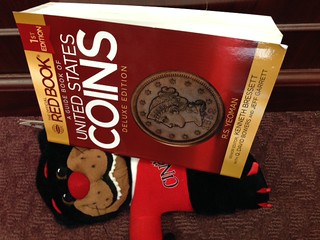 After seeing this notice in the last issue of The E-Sylum I decided to do some research. I am a resident of Ohio and did not know
of any ostrich herds close but was eventually able to find the one in question. I was able to take the following photo while visiting the
site of the "crime". Ostrich farmer Smith would like to pass his thanks to the publisher for creating a book that is as useful
in the field to protect his flock as it is in the bathroom to take up all that free time now that Sears is no longer printing their
catalog.
After seeing this notice in the last issue of The E-Sylum I decided to do some research. I am a resident of Ohio and did not know
of any ostrich herds close but was eventually able to find the one in question. I was able to take the following photo while visiting the
site of the "crime". Ostrich farmer Smith would like to pass his thanks to the publisher for creating a book that is as useful
in the field to protect his flock as it is in the bathroom to take up all that free time now that Sears is no longer printing their
catalog.
Bears beware!
To read the earlier E-Sylum issue, see:
Volume 18, Number 19, May 10, 2015
(www.coinbooks.org/club_nbs_esylum_v18n19.html)
On Tommy Thompson's Fate
Regarding the finder of the SS Central America treasure, Dave Bowers writes:
I hope that all works out well for Tommy Thompson in the end, and for the Columbus investors as well. What could have been a memorable fortune for ALL involved was dissipated in a decade of lawsuits that ate up most of the money and, no doubt, was more than dispiriting to Tommy.
To read the earlier E-Sylum article, see:
S.S. CENTRAL AMERICA COMMEMORATIVE RESTRIKE CLUES
(www.coinbooks.org/esylum_v18n19a37.html)
THE BOOK BAZARRE
THE ARCHER M. HUNTINGTON MEDAL
The medal was designed by the Austro-American sculptor Emil Fuchs (1866-1929) and originally struck by the firm of Whitehead & Hoag, with later strikings done by the Medallic Art Company. The medal was first proposed at the 1908 meeting in celebration of the American Numismatic Society’s fiftieth anniversary as a way to honor those who had made a substantial contribution to numismatics.
Archer Huntington both recommended Fuchs and provided some direction for the design, which he did not want to feature his portrait. The resulting obverse shows two workers standing on either side of a coin press, while a seated man in the foreground examines a coin with a magnifying glass.
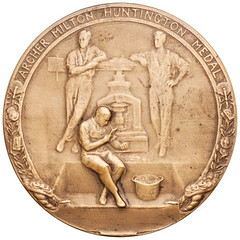
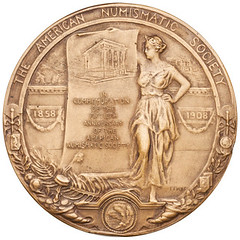
The rather more elaborate obverse features a classically-garbed woman holding a scroll upon which the Society’s then new building in Audubon Terrace is pictured and text commemorating its fiftieth anniversary.
A solitary gold specimen was struck and presented to Archer Huntington, and both bronze and silver medals have been given to the awardees over the last hundred years. For more about this piece, and the many other medals struck under the auspices of the ANS, see Scott H. Miller’s new book Medallic Art of the American Numismatic Society, 1865-2014 (2015).
To read the complete article, see:
THE ARCHER M. HUNTINGTON AWARD AND MEDAL
(www.anspocketchange.org/huntington-award-and-medal/)
QUERY: COL HARDY CRIER TOKEN ODD DENOMINATION
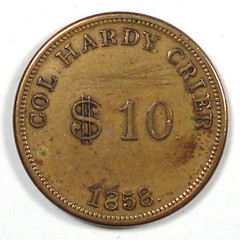
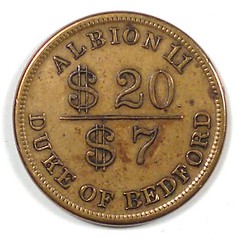
A local dealer asked me about the strange denomination on the above token. I didn’t have an answer for him.
Miller Md 68 is an odd token, with a $10 denomination on one side and a fractional $20 / $7 denomination on the other. I assume those aren’t really denominations, but what are they?
Rulau doesn’t have any firm information: “The inscription suggests horse race betting, but nothing is known of this strange token’s raisen d’etre.” A March 1907 edition of The Numismatist had even less information: “Nothing has been learned regarding the inscription on the reverse.”
Does anyone have more recent information about the significance of the wacky $7 denomination, or whatever it is?
SOME INTERESTING TOKENS FROM BALDWIN'S: MAY 15, 2015
1874 Trinidad Farthing
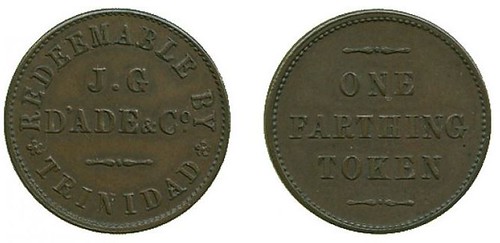
Trinidad, J.G. D’Ade & Co., copper Token Farthing, ND (1874), name, REDEEMABLE BY/ TRINIDAD, rev ONE FARTHING TOKEN (Prid. 6; Lyall 498; KM Tn2). Very light spotting, nearly extremely fine, scarce.
To read the complete item description, see:
Scarce Trinidad Farthing struck in 1874
(www.baldwin.co.uk/scarce-trinidad-farthing-struck-in-1874.html)
1814 St Vincent Token
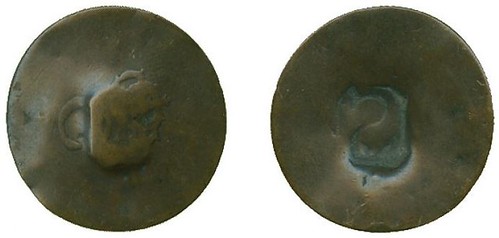
St. Vincent, billon Stamped Token, ND (1814), a French colonial coin, crowned C, with countermark of retrograde S on reverse (Pr.14; KM 8). Fine
To read the complete item description, see:
St Vincent Token c.1814
(www.baldwin.co.uk/st-vincent-token-c-1814.html)
St Lucia Geest Industries Token
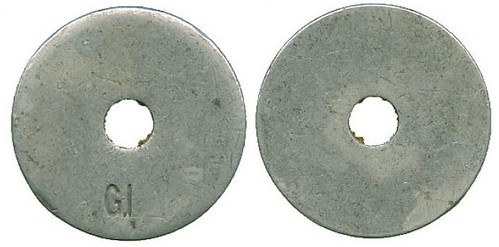
St. Lucia, Geest Industries Ltd. (banana exporters), aluminium Token, plain on both sides except small G.I incuse stamp at foot of one side, central hole, 2.44g, 22mm. (Lyall 473). Small edge knock, fine, rare.
To read the complete item description, see:
Rare St Lucia Geest Industries Token
(www.baldwin.co.uk/rare-st-lucia-geest-industries-token.html)
THE BOOK BAZARRE
HARRIET TUBMAN RECOMMENDED FOR THE U.S $20 NOTE
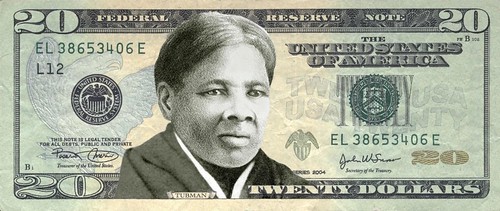
A group that wants to kick Andrew Jackson off the $20 bill and replace him with a woman has, after months of collecting votes, chosen a successor: Harriet Tubman.
Tubman, an abolitionist who is remembered most for her role as a conductor in the "Underground Railroad," was one of four finalists for the nod from a group of campaigners calling themselves "Women on 20s." The campaign started earlier this year and has since inspired bills in the House and the Senate.
The other three finalists were former first lady and human rights activist Eleanor Roosevelt; civil rights figure Rosa Parks; and Wilma Mankiller, the first female chief of the Cherokee Nation. Women on 20s delivered a petition with the people's choice to the White House on Tuesday morning.
“Our paper bills are like pocket monuments to great figures in our history,” Women on 20s Executive Director Susan Ades Stone said in an e-mailed statement. “Our work won’t be done until we’re holding a Harriet $20 bill in our hands in time for the centennial of women’s suffrage in 2020.”
In Tuesday's White House press briefing, Press Secretary Josh Earnest said that Tubman was a "wonderful choice" for the bill, but stopped short of saying whether the President backs putting Tubman on the $20.
If the government agrees that it's time to replace Andrew Jackson on the bill, its choice might not end up being Tubman. But the idea of putting a woman on America's paper currency has attracted some notable support.
Although the Women on 20s campaign plans to petition the White House, it is the Treasury Department that ultimately makes decisions on which bills feature which portraits. The last overhaul of paper money portraits by the department was in the 1920's, when Jackson replaced Grover Cleveland on the $20.
To read the complete article, see:
Harriet
Tubman is your potential replacement for Jackson on the $20
(www.washingtonpost.com/blogs/the-fix/wp/2015/05/12/your-potential-replacement-for-andrew-jackson-on-the-20-bill-harriet-tubman/)
Raven-Symoné faced a huge online backlash after revealing that she does not believe Harriet Tubman should be placed on a $20 note, claiming that she is not ‘progressive’ enough.
The 29-year-old actress made the comment while guest-hosting US talk show, The View.
Symone – who found fame on Disney’s That’s So Raven – disagreed with the outcome of an online poll which saw Tubman come top out of a list of potential female replacements for former President Andrew Jackson.
"I think we need to move a little bit more forward. Let me just preface that I understand the history, I get it, trust me, I was taught, I'm in that culture. There’s also Rosa Parks, Eleanor Roosevelt. I personally would’ve chosen Rosa Parks.”
To read the complete article, see:
Raven-Symone branded 'ignorant' for claiming Harriet Tubman is not 'progressive' enough to feature on a bank note
(www.standard.co.uk/showbiz/celebrity-news/raven-symone-branded-ignorant-for-claiming-harriet-tubman-is-not-progressive-enough-to-feature-on-a-bank-note-10251585.html)
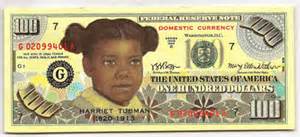

EARL & KOEHLER LINCOLN CENT COIN BOARD SURFACES
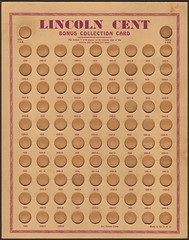 After the publicity I received from the record price paid for a coin board, I received a call from someone
who had an example of the same publisher's coin board for Lincoln Cents that he was willing to sell. While a cent board of Earl &
Koehler is not quite as rare as the Buffalo Nickel board sold previously, it's still big news when another E & K board surfaces. We
quickly came to an agreement on price, and the board arrived within a few days. It turned out to be a known variety, Lange number EK1cAb.1,
and it was in the same grade as the one in my own collection.
After the publicity I received from the record price paid for a coin board, I received a call from someone
who had an example of the same publisher's coin board for Lincoln Cents that he was willing to sell. While a cent board of Earl &
Koehler is not quite as rare as the Buffalo Nickel board sold previously, it's still big news when another E & K board surfaces. We
quickly came to an agreement on price, and the board arrived within a few days. It turned out to be a known variety, Lange number EK1cAb.1,
and it was in the same grade as the one in my own collection.
 Here's what really makes the story memorable: Bill Koehler, son of coin board co-publisher Frank
Koehler, had been seeking one of his father's boards for some time. I had to work my way down my want lists from customers before I
could finally secure this one for him, and now it will be returning to the family that produced it way back in 1939.
Here's what really makes the story memorable: Bill Koehler, son of coin board co-publisher Frank
Koehler, had been seeking one of his father's boards for some time. I had to work my way down my want lists from customers before I
could finally secure this one for him, and now it will be returning to the family that produced it way back in 1939.
To read the earlier E-Sylum article, see:
EARL & KOEHLER COIN BOARDS BRING RECORD PRICE
(www.coinbooks.org/esylum_v18n13a11.html)
MORE ON U.S. MINT CLIPPINGS RECEIPTS
In the last E-Sylum, the receipt from Carson City by the Superintendent for the gold clippings was very cool.
There is a reason that this receipt was by the Carson City Superintendent at this time.
Prior to the Mint Act of 1873, the Treasurer would have received these clippings, just as he would receive all of the struck coins. The 1873 Act removed the Treasurer from the Mint and changed the delivery of clippings and coins to the office of the Superintendent. Prior to 1873, the Mint Director was the de facto Superintendent in Philadelphia. This act split these positions with the Mint Director removed to Washington. The branch mints always had Superintendents, of course with Philadelphia finally having this position starting in 1873.
The first Philadelphia Superintendent was former Mint Director James Pollock. He served as Superintendent from 1873 to 1879, when Col. Archibald Loudon Snowden took over the position (1879-1885). Because the Superintendent received all the coins, one can imagine how things went. Snowden had been Chief Coiner from 1866 to 1876, so after becoming the Superintendent in 1879, he was able to easily obtain some very interesting items! There is a reason the only 1884 and 1885 Trade dollars appeared in the marketplace in the early twentieth century, as well as the "believed melted" two 1877 Half Unions sold to William Woodin in 1909 for $10,000 each. The good Col. Snowden died in 1912.
Attached is a Philadelphia receipt for silver clippings and delivered coins from 1868 to the Mint Treasurer. Also attached is one from July 1873, where the Treasurer is marked out and Superintendent is added.
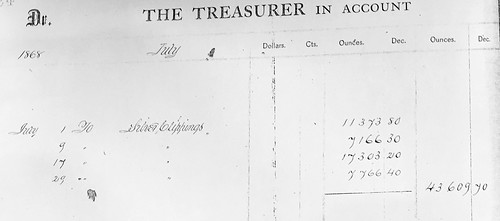

To read the earlier E-Sylum article, see:
A CARSON CITY MINT GOLD CLIPPINGS RECEIPT
(www.coinbooks.org/esylum_v18n19a22.html)

1941 PANAMA 'ARIAS' CURRENCY ISSUE
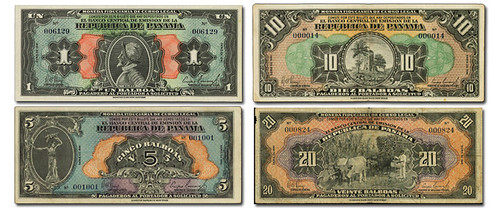
The “Banco Central d Emision de la Republica de Panama,” banknotes issued in 1941 are a numismatic favorite and always attract great interest among collectors when offered at auction. The series comprised just four denominations with One, Five, Ten and Twenty Balboa notes produced. The notes were printed by the Hamilton Bank Note Company of New York and each of the denominations employed bold contrasting colors with identical format size. Vignettes changed through the four notes along with the color selections. The only readily available note of the series is the One Balboa, which due high demand still commands a low four-figure price in average circulated grades.
The series is commonly referred to by the nickname “The Arias Issue,” which references President Dr. Arnulfo Arias. The President was largely responsible for the introduction of a new article which would authorize official and private banks to circulate paper money and the first and only bank to do so was the Banco Central Emision de la Republica de Panama. The bank received the authority to circulate up to six million Balboas in banknote form, although a little less than half that number was released on October 2, 1941.
The most fascinating aspect of this series was the incredibly short period of circulation, lasting over a week. This short stint was due to Dr. Ricardo Adolfo de la Guardia Arango becoming president in a cooperative with the United States. The new leadership quickly closed the bank and withdrew the notes from circulation, at the same time destroying the remaining stocks. The short circulation period resulted in the high rarity of the notes today, especially the higher denominations.
To read the complete article, see:
Panama 1941 “Arias” Currency Issue (www.stacksbowers.com/NewsMedia/Blogs/TabId/780/ArtMID/
2678/ArticleID/65142/Panama-1941-%E2%80%9CArias%E2%80%9D-
Currency-Issue-.aspx)
2014 IBNS BANK NOTE OF THE YEAR NOMINEES
The selection is based on a nomination and voting process by IBNS’s more than 2,000 members. The runner-up prize went to the 5000 Franc note from the French Pacific Territories (Tahiti), and third place went to the 10 Dinar bill from Kuwait.
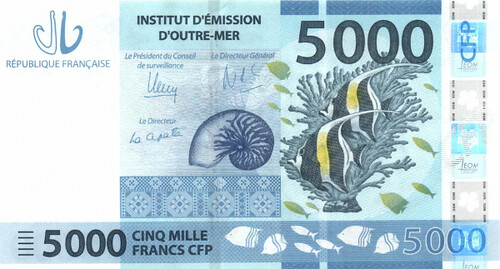
French Pacific Territories 5,000 Franc Note
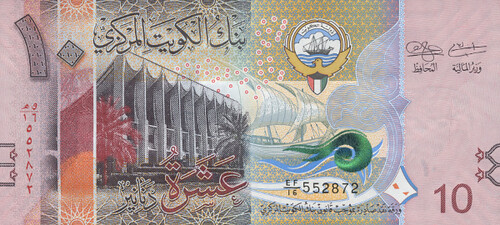
Kuwait's 10 Dinar Note
Kazakhstan (2013, 2012, 2011), Uganda (2010), Bermuda (2009), Samoa (2008), Scotland (2007), Comoros (2006), Faeroe Islands (2005) and Canada (2004) have previously garnered the top prize. Established in 1961, IBNS is a nonprofit educational organization that aims to advance the study, collection and dissemination of information related to paper money. Membership is open to all enthusiasts from any country in the world.
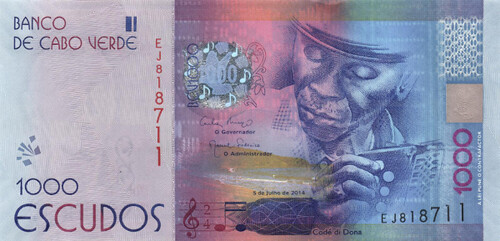
Cape Verde's 1000 Escudos note
To read the complete article, see:
The world’s best banknotes of the year
(http://qz.com/405425/the-worlds-best-banknotes-of-the-year/)
To read the earlier E-Sylum article, see:
2014 IBNS BANK NOTE OF THE YEAR WINNER
(www.coinbooks.org/esylum_v18n19a28.html)
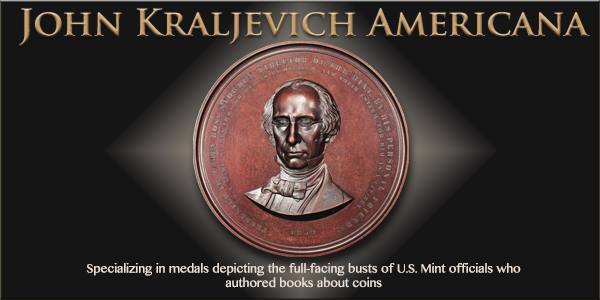
STARVING LIBERTY ZOMBUCKS
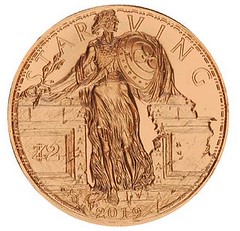
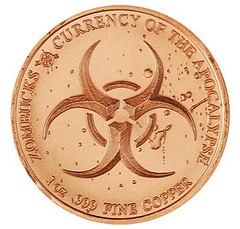
Zombucks are a popular silver and copper bullion series from Provident Metals.
Coin World explores all of the designs issued so far in the series.
Starving Liberty is the seventh of 10 designs in the Zombucks series.
Instead of the Standing Liberty quarter dollar design created by Hermon MacNeil, a disheveled, skeletal Lady Liberty stands atop a stone staircase clutching a shield. She wears partially torn armor, showing the toll the apocalypse has taken on her body. STARVING is inscribed above, Z2 beside, and 2019 below her emaciated form.
To read the complete article, see:
Starving Liberty Zombucks puts
Standing Liberty on a diet (www.coinworld.com/insights/starving-liberty-zombucks-puts-standing-liberty-on-a-diet.html#)
THE WISCONSIN TOKEN COLLECTION
John and Nancy Wilson write:
The Numismatists of Wisconsin site has excellent information from Roger Lalich regarding collections in the Wisconsin Historical Society and a CWT from the Milwaukee public museum collection. Besides the token collection the WI historical society has an outstanding collection of Wisconsin obsolete notes which were cataloged some years back by Wendell Wolka.
The Historical Society also maintains a wide range of artifacts. Wisconsin tokens are part of this collection. A search of their database using the words “Wisconsin” or “Milwaukee” and “token” yields almost 600 token listings. The following is a summary of what is included in their collection.
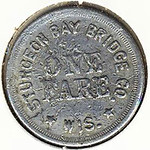 Transportation tokens: There are over 140 tokens for bus, rail (mainly streetcar/trolley)
and boat transportation. Several toll road/bridge tokens are included. The tokens are of various metals, plastic and wood. Thirty-one
municipalities are represented. Of particular interest is an 1866 25-cent toll token for the lower falls bridge in Black River Falls. There
are four Wood Co. Bridge Co. (Wisconsin Rapids) tokens, circa 1870. Denominations include 2½, 15 and 25 cents. Most, if not all, Wood
County Bridge Company tokens were struck over Civil War tokens but the Historical Society tokens show evidence of being over-struck.
Transportation tokens: There are over 140 tokens for bus, rail (mainly streetcar/trolley)
and boat transportation. Several toll road/bridge tokens are included. The tokens are of various metals, plastic and wood. Thirty-one
municipalities are represented. Of particular interest is an 1866 25-cent toll token for the lower falls bridge in Black River Falls. There
are four Wood Co. Bridge Co. (Wisconsin Rapids) tokens, circa 1870. Denominations include 2½, 15 and 25 cents. Most, if not all, Wood
County Bridge Company tokens were struck over Civil War tokens but the Historical Society tokens show evidence of being over-struck.
Pre-Civil War tokens: Wisconsin tokens prior to 1860 are five A. B. Van Cott (Racine) tokens, circa 1850, and five 1850 Hopkins Western Publishing (Milwaukee) tokens.
Wooden Nickels: There are seven wood tokens from five municipalities. Lumber Company tokens: Two lumber companies are represented. Ten Connor Lumber (Laona) tokens are included, circa 1904. Denominations of 5, 10, 25 and 50 cents and $1 are brass and the $5 token is aluminum. Charles R. Smith Mill (Neenah) has two tokens, holed as struck, circa 1890.
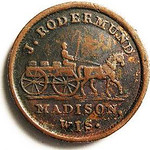 Civil War tokens: The largest token set is comprised of Wisconsin Civil War store card tokens,
with 295 pieces. Some are duplicates but there is a very good representation of towns and varieties. There are 22 tokens with rarity 7 (11
to 20 known to exist). 13 tokens are rarity 8 (5 to 10 known). These R8 tokens are from Fond du Lac, Mayfield, Milwaukee, North Prairie,
Oshkosh, Racine, Sheboygan, Watertown and Whitewater. Three rarity 9 (2 to 4 known) tokens are in the collection. These R9 tokens are from
Joseph Fischbein of Milwaukee (WI-510-K-3a1), Severn & Jones of Milwaukee (WI-510-AJ-2a) and the Madison Brewery of John Rodermund (Fuld
WI-410-G-3a).
Civil War tokens: The largest token set is comprised of Wisconsin Civil War store card tokens,
with 295 pieces. Some are duplicates but there is a very good representation of towns and varieties. There are 22 tokens with rarity 7 (11
to 20 known to exist). 13 tokens are rarity 8 (5 to 10 known). These R8 tokens are from Fond du Lac, Mayfield, Milwaukee, North Prairie,
Oshkosh, Racine, Sheboygan, Watertown and Whitewater. Three rarity 9 (2 to 4 known) tokens are in the collection. These R9 tokens are from
Joseph Fischbein of Milwaukee (WI-510-K-3a1), Severn & Jones of Milwaukee (WI-510-AJ-2a) and the Madison Brewery of John Rodermund (Fuld
WI-410-G-3a).
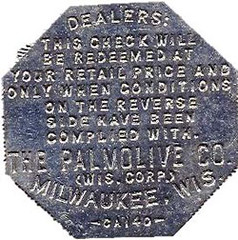 Good
For tokens: Only 17 “good for” tokens are represented from 10 locations. They are for rides, soda, popcorn, towel checks, beer, parking
and games. The Palmolive Company (Milwaukee) has four tokens, circa 1916 to 1926, redeemable for soap.
Good
For tokens: Only 17 “good for” tokens are represented from 10 locations. They are for rides, soda, popcorn, towel checks, beer, parking
and games. The Palmolive Company (Milwaukee) has four tokens, circa 1916 to 1926, redeemable for soap.
Political tokens: The only Wisconsin political token is for the 1900 Republican State Convention (William McKinley/Theodore Roosevelt).
Denominational tokens: Sixty denominational tokens are present, with most of these representing taverns. Denominations range from 2½ cents to $5. The $5 token is from Bloch Furniture and Carpet Company (Racine). Sixteen tavern tokens do not list any amount. Twenty-eight municipalities are included in these tokens.
Dairy tokens: Only two dairy tokens are present from Madison and Middleton dairies.
Advertising tokens: Eighteen advertising tokens are included from ten companies.
Fraternal tokens: Six Masonic tokens from Madison, Oconto and Portage and one Milwaukee Elks token from 1901 are present.
There are probably more Wisconsin tokens in the collection that would be evident if different searches of the Wisconsin Historical Society collection database were conducted. Perhaps searches of “lumber” or “dairy,” along with “token,” would yield additional results. Incidentally, using only “token” as a search word gives 1,256 entries. Included in this less restrictive search is a set of Hudson Bay Company tokens.
The database can only be searched by the staff of the Wisconsin Historical Society. This is because of the incomplete state of the catalog records and because a thorough knowledge of the records is required. There are 150 years of records that still need to be converted to an electronic format, which is expected to take many years. Many records are worksheets not yet cataloged digitally.
The tokens are difficult to personally examine because they are currently boxed in preparation for a move to new storage. Pictures, however, are available with the database searches.
To read the complete article, see:
The Wisconsin Historical Society Wisconsin Token Collection
(www.numismatistsofwisconsin.com/now-wihistorical.html)
THE ALL-IRELAND HURLING MEDAL
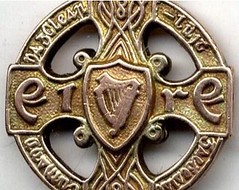
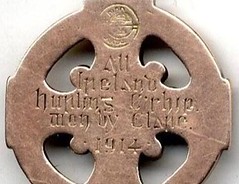
GAA memorabilia seems to be growing in popularity among collectors in Ireland and throughout the diaspora.
Fonsie Mealy Auctioneers has an interesting selection in an auction at Kilkenny’s Ormonde Hotel on Tuesday .
Among the highlights is a medal awarded to one of the Clare team that won the All-Ireland hurling final in 1914 by beating Laois. “This is an extremely rare medal,” the auctioneer said, and has an estimate of €7,000-€10,000 .
A set of three All-Ireland medals (1907, 1911 and 1913) won by Kilkenny’s John T Power (a goalkeeper) has an estimate of €10,000- €15,000.
A medal awarded to a Kilkenny hurler on the winning side of the famous 1939 “thunder and lightning final” – played on September 3rd just hours after the second World War started – against a Cork side whose players included Jack Lynch (later a Fianna Fáil taoiseach) is estimated at €2,000-€3,000.
To read the complete article, see:
Auction of GAA memorabilia includes Clare’s first All-Ireland hurling medal
(www.irishtimes.com/life-and-style/homes-and-property/fine-art-antiques/auction-of-gaa-memorabilia-includes-clare-s-first-all-ireland-hurling-medal-1.2212784)
To read the earlier E-Sylum article, see:
IRISH SPORTS MEDALS AUCTIONED (www.coinbooks.org/esylum_v11n18a22.html)

Archives International Auctions, Hong Kong 5
The Alexander I. Pogrebetsky Family Archives of Chinese & Asian Banknotes
Highlights include:
- Lot 2474 Mercantile Bank of India, 1937 Issue
- Lot 2119 Yue Soo Imperil Bank, 1908 Silver Dollar Issue
- Lot 2024 Bank of Territorial Development, 1915 Issue 5 Dollars
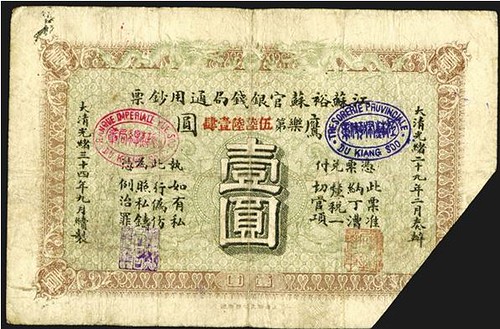
1580 Lemoine Avenue, Suite #7
Fort Lee, NJ 07024
Phone: 201-944-4800
Email: info@archivesinternational.com
WWW.ARCHIVESINTERNATIONAL.COM
DOUBLE COIN LIBERTY SEATED LOVE TOKEN
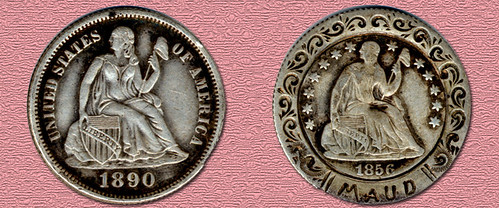
Well, at least it's currently the "coolest" in my personal collection. Among other things, I collect Liberty Seated dime love tokens by date. To make it into my collection of more than 150 pieces, each love token must be unholed and unmounted – I'm down to eight dates needed for completion. Love tokens have always fascinated me. If one blanket statement could be made about love tokens, it would be "all love tokens are unique."
My most recent acquisition is unquestionably unique. In fact, this 1890 Liberty Seated dime love token has a face value of 15 cents! The host coin is pleasing EF overall with good eye appeal. The reverse of this unusual piece has an 1856 half dime embedded at the center with an array of flourishes encircling the rim and MAUD at the bottom. Who was Maud and what is the significance of the two dates? If Maud was born in 1856, she would have been 34 years old in 1890. Perhaps she was married and this was from her hubby on her birthday, or it could be a memorial to someone who died at just 34 years old.
That's the fascination of love tokens to me. Each token is yearning to tell a story, but the tale it tells is left entirely up to my imagination. I have numerous "pictorials" in my collection, coins with images instead of just initials, and I've got love tokens from all the branch mints in multiples as well in my hoard. Many of them are quite interesting, but for now the 1890 "15-cent" piece is the star of the collection!
To read the complete article, see:
“The
Coolest Love Token Ever!” (www.stacksbowers.com/NewsMedia/Blogs/TabId/780/ArtMID
/2678/ArticleID/65144/%E2%80%9CThe-Coolest-Love-Token-Ever%E2%80%9D.aspx)
WAYNE’S NUMISMATIC DIARY: MAY 17, 2015
Has it been another month already? Tuesday May 12th brought the monthly gathering of Nummis Nova, my Northern Virginia numismatic social group. Aaron Packard was our host, and he'd selected a cozy place called Southside 815 in Alexandria. I arrived early and found a parking spot on the street nearby. Inside Dave Schenkman, Ron Abler and Gene Brandenburg were already seated at one of our two tables. I took a seat across from Ron. Soon Eric Schena and Lenny Goldberg were at my right and left, respectively. Other regulars arrived shortly, including Jon Radel, Tom Kays, and Joe Levine. Here's a shot of my table taken after dinner. From the left: Tom Kays, Jon Radel, Ron Abler, Gene Brandenburg, Aaron Packard (visiting), Dave Schenkman and (off-camera) Eric Schena.
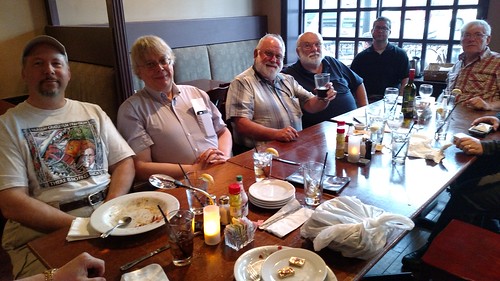
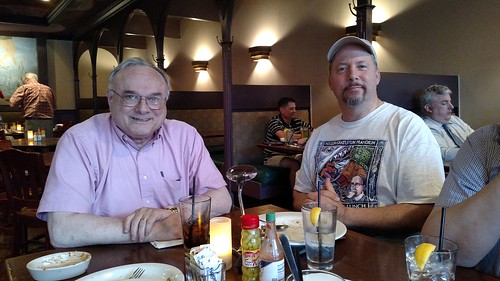
Joe Levine and Tom Kays
Before I could get settled Gene was already pouring me a glass from his newly opened bottle of Shiraz. I thanked him for that, and his comment on our Meetup web page:
In case anyone's curious, Julian's an expert at the Rumba, Foxtrot and that dance that the Teletubbies used to do on PBS mornings...
At the table behind me were Mike Packard, Wayne Herndon, Steve Bishop, and Julian Leidman himself. He didn't dance, despite a number of invitations. When my guest for the evening arrived I introduced myself and got him a seat there next to Mike Packard. Joe Esposito is a longtime E-Sylum reader from Fairfax, and he shares interests in Colonials with Mike and Morgan Dollars with Steve. Joe's profile appears elsewhere in this issue.
Joe was curious about the Newman Numismatic Portal project, so I sat down with him and talked for a while before returning to my seat.
Recent Numismatic Publications
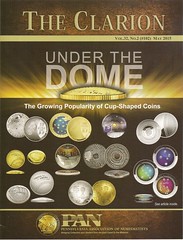 For my exhibit I brought along three recent numismatic publications
of note, starting with the May 2015 issue of The Clarion, published by the Pennsylvania Association of Numismatists. Editor Rich
Jewell has been doing a wonderful job filling its pages with great articles. The cover article is Under the Dome: The Growing
Popularity of Cup-Shaped Coins by Tom Uram. Other articles include The John Wanamaker Medal by Harry Waterson and A
Token's Story: "The Strawberry" by Henry "Doc" Stouffer.
For my exhibit I brought along three recent numismatic publications
of note, starting with the May 2015 issue of The Clarion, published by the Pennsylvania Association of Numismatists. Editor Rich
Jewell has been doing a wonderful job filling its pages with great articles. The cover article is Under the Dome: The Growing
Popularity of Cup-Shaped Coins by Tom Uram. Other articles include The John Wanamaker Medal by Harry Waterson and A
Token's Story: "The Strawberry" by Henry "Doc" Stouffer.
The other items were books recently profiled in The E-Sylum - Dick Hanscom's book on Alaska numismatics, and Larry Lee's book on the coins of Fort Atkinson. I was glad Tom Kays was in attendance and lent him my copy so he could write a review, which appears elsewhere in this issue. As a student of foreign coins used in Colonial America, he's far more qualified than I am to discuss the subject.
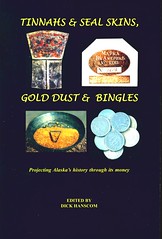

Query: What's a "Cowbuck"?
We also talked about possible meanings for the term "cowbuck". We were all so stumped we decided to ask E-Sylum readers.
Tom Kays writes:
Readers are asked to help solve a mystery regarding the 19th century use of the term “cowbuck.” The diary of a certain Colonel W. of Winchester used the term “cowbuck” quite often, but without sufficient context to tell what it means. Perhaps it is 19th century slang? Cowbuck is certainly not in the Oxford English Dictionary (OED). So to “coin a phrase” The E-Sylum may one day be cited as primogeniture of “cowbuck.”
Be sure and use it around the office and at home in daily conversation. As in the game Balderdash if you don’t know, yet want to respond, tell us what you think “cowbuck” ought to mean. What other numismatic sounding words are as yet undefined, fodder for budding wordsmiths of Shakespearean or perhaps “Seussian” dimension?
I don't know about Colonel W.'s day, but to my ears "cowbuck" sounds like an alternative currency. Or maybe a coupon from Chick-Fil-A. "Cowbuck" is a family name, so perhaps the Colonel was referring to a person. Thoughts, anyone?
Ft. Lee Logistical Exercise Scrip
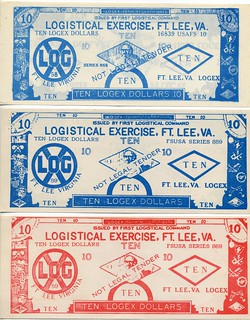
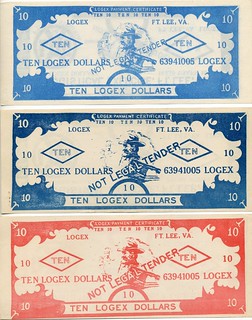
Eric Schena writes:
For the evening's theme of new acquisitions, I brought a couple of Virginia tokens to show Dave and Gene (one from Doe Hill in Highland County and one from Mt. Jackson in Shenandoah County).
I also brought a trio of Logistical Exercise (LOGEX) scrip from Fort Lee, near Petersburg, Virginia, one from the 1958 exercise (the top note) and a pair from the 1959 exercise. The notes were used to train logistics officers on Military Payment Certificate conversion days ("C-days") from an old series to a new series. C-days were unannounced and carefully orchestrated affairs in order to neutralize any profiteering on the black market.
There are two colors for each exercise, red and blue. From what I can tell, a pair of blue tens was stapled together along with a typed up instruction to keep the notes in your wallet because at some time during the exercise there will be an exchange (I am trying to get a copy of that note). The red and the blue scrip colors reminded me of an episode of the television show M*A*S*H where the main plot device is a scrip change day. Fortunately, the full episode is available on YouTube.
To view the M*A*S*H episode, see:
MASH Season 6 Episode 8 (S06E08) - Change Day
(www.youtube.com/watch?v=QbLq6VOeMTw)
Mining Scrip Notes
At the head of the table nearby sat Dave Schenkman, and he bought with him some Mining scrip notes purchased in the recent Heritage auction
for display.
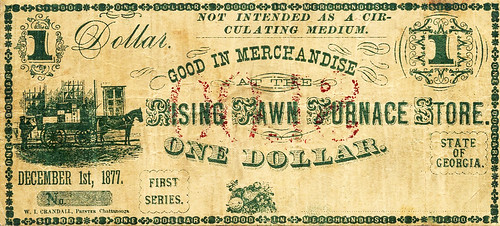
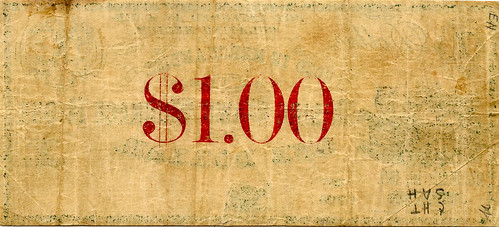
Dave writes:
1881-dated notes from Rising Fawn Furnace are seen frequently. This 1877 “First Series” note is not.
I enjoyed the large disclaimer that it is "Not Intended as a Circulating Medium", despite being good for a dollar in the store.
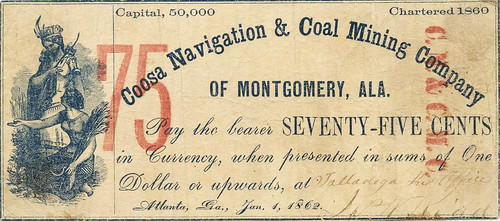
Dave writes:
Despite the fact that ATLANTA, GA is printed on these notes, they were payable at Talladega, Alabama, and that is undoubtedly where the mine was located. The company was incorporated in Alabama in 1860.
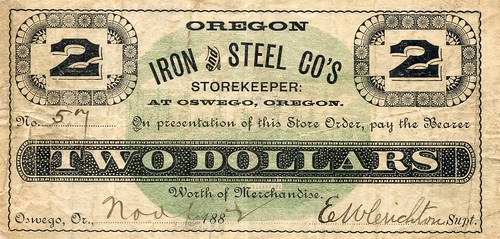
Dave adds:
Any note from this iron company is extremely rare. The Schingoethe collection included 5 Cents and Three Dollar denominations; I can’t recall any others. This one is from Eric Newman’s collection. Heritage noted that the “Ford collection did not contain any Oregon store bills despite over fifty years of searching.”
More Exhibits
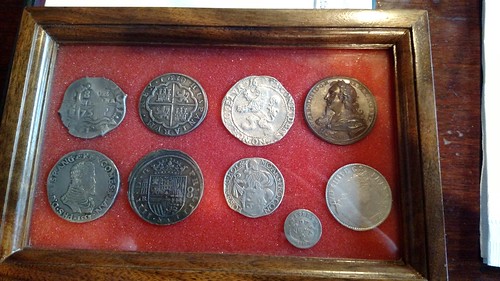
Another exhibit at the meeting was this great display box of coins and medals. In the walnut relic case under glass are newly acquired coins ranging in date from 1557 – 1731 including Spain (Philip II and Philip IV), Peru (Charles II), France (Louis XV), and Low Countries big silver coins of full and demi-dollar/thaler sizes along with a Charles I Death Medal and a last minute addition of 12 Sols from the Windward Islands.
Mike Packard’s theme was a popular one of “what’s new in your collection?” So there is little rhyme or reason for this display, and in fact all the coins are quite old. Perhaps next time a better display with regard to “newness” if that is what Mike wants, might feature the newest National Park quarter. Anything goes at pre-supper show-and-tell so long as it has numismatic relevance, or even utter irrelevance so long as it makes for a good dinner conversation.
Steve's Eclectic Mix
Steve Bishop brought a number of different items. The emphasis should be on the word 'different'. They’re all over the collecting
map. He kindly sent some images.
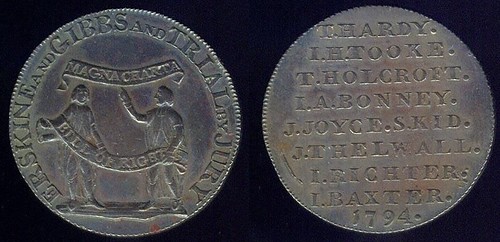
1794 Conder Token on the Magna Carta and Bill of Rights
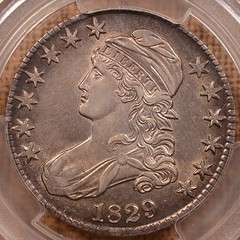
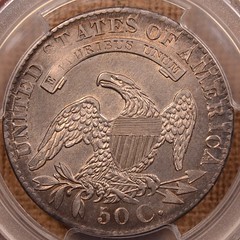
1829 Half Dollar
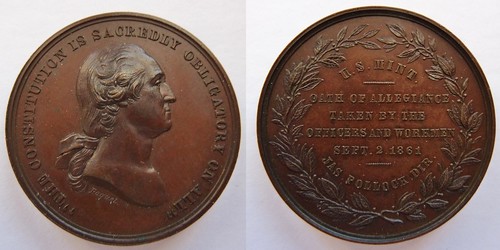
1861 Mint Allegiance Medal
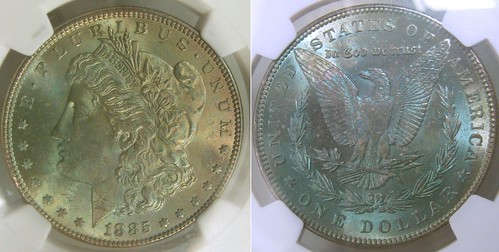
1885 Morgan Dollar
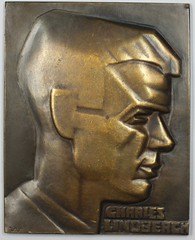
Cubist Lindbergh Medal by Oscar Nemon
The image doesn't do justice to the toned reverse of the Morgan Dollar - it's a stunning beauty. The U.S. Mint medal is another beauty. I'd never seen this particular Lindbergh medal, and it may be the first I've ever seen in the Cubist style. To some, it reminded them of Mr. Spock of the Starship Enterprise.
Later in the evening I introduced Tom Kays to Joe Esposito and they seemed to hit it off well, talking for a good while about colonial coins and books on colonials.
Regulars Roger Burdette, Chris Neuzil and Howard Daniel were missed. It was another great night of numismatic fellowship. These get-togethers are the highlight of the month for many of us. 'Til next time.
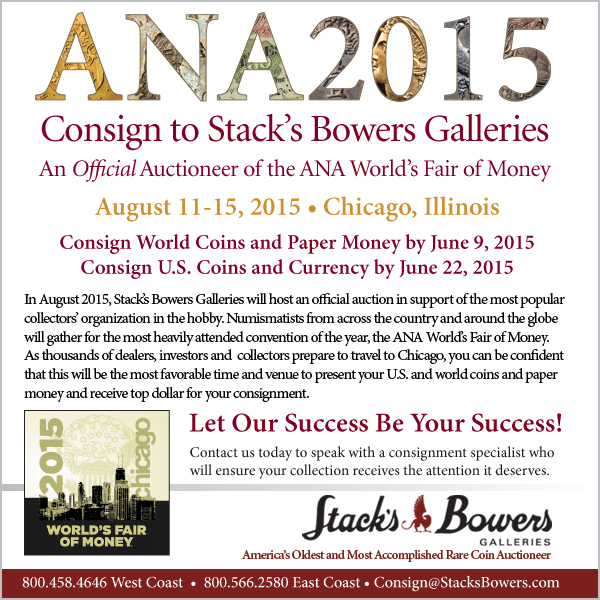
1793 CENT FLOWN ON GEMINI VII SPACECRAFT
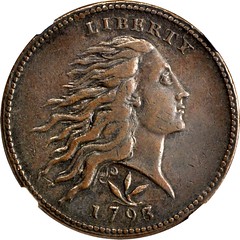
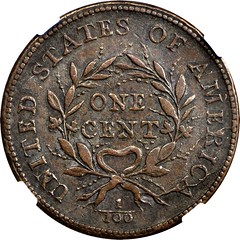
It is rare occurrence that items we offer are of strong interest to numismatic and non-numismatic buyers alike, and rarer still when an item can truly be described as one-of-a-kind. This is undeniably such a piece, and is one of the most historically significant pieces of American numismatics that has come to market in recent years. Further, this is the first time it has been offered for sale at public auction, and it may well be the last.
In the early days of the space program, it was not uncommon for astronauts to take personal items of nominal value with them as souvenirs on their missions. NASA formalized this practice by allowing astronauts to take a small bag known as a Personal Preference Kit (PPK) wherein each item was validated by NASA. The contents of these bags were limited by necessity and design, and were generally quite private. Only once have the contents been made public, that of Wally Schirra on the Gemini 6A mission; the handwritten inventory reads:
"Navy wings, 33rd Degree Masonic ring, 1950D coin, dime-sized memento, 5c-sized memento, miniature Gemini s/c, Fla. hunting license, 20 gold medals, 5 silver medals, various flags, and 15 GTA-6 patches."
These personal items were not intended for sale by the astronauts, but were instead given to friends and family. In recent decades, various items from some of the PPKs have been offered for sale to eager collectors of space memorabilia. Of the few known coins that have flown in space, most are pieces of fairly low numismatic value, and only a handful have ever been offered at public auction. The present lot is clearly very much unlike any other, with an obvious numismatic value to collectors, and is further made unique in that it was not included in an astronaut's PPK but was surreptitiously slipped into the inflight medical kit, without NASA's prior knowledge.
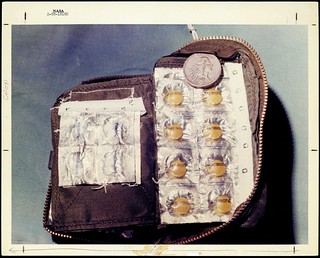 Accompanying documentation and correspondence reveal that flight surgeon Howard A. Minners
placed this cent, owned at that time by William Ulrich, in the inflight medical kit of the Gemini VII spacecraft at his request, an action
that Minners later described as "just one more public relations type of thing done in the space program."
Accompanying documentation and correspondence reveal that flight surgeon Howard A. Minners
placed this cent, owned at that time by William Ulrich, in the inflight medical kit of the Gemini VII spacecraft at his request, an action
that Minners later described as "just one more public relations type of thing done in the space program."
Another letter to William Ulrich, dated January 25, 1966, and written on NASA letterhead, certifies "[T]hat a 1793 United States wreath cent...was carried into space in the Inflight Medical Kit aboard the Gemini VII spacecraft" and is signed by Command Pilot Frank Borman, Pilot James A. Lovell, and by Howard A. Minners, M.D. An additional letter from Minners to Ulrich dated March 9, 1966, and written on NASA letterhead accompanies an 8 x 10 color image of this same coin inside the medical kit that Minners indicates was taken on December 18, 1965, approximately four hours after the Gemini spacecraft landed.
To read the complete lot description, see:
Exceptionally Important and
Desirable 1793 Wreath Cent (www.stacksbowers.com/BrowseAuctions/LotDetail/
tabid/227/AuctionID/6109/Lot/42/Default.aspx)
ROMAN COIN HOARD FOUND IN READING
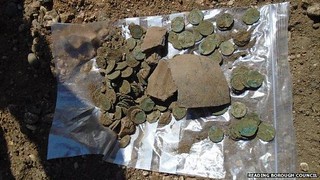 A hoard of Roman coins has been unearthed in the grounds of a primary school in Reading.
A hoard of Roman coins has been unearthed in the grounds of a primary school in Reading.
A pot with up to 300 coins was discovered during an archaeological exploration of the site before The Ridgeway School's redevelopment works.
Experts believe the container was buried by a Roman citizen or farmer for safe keeping, possibly during a time of crisis or threat.
Once assessed, there are plans to display the coins at Reading Museum.
Investigations have shown there was probably a small Roman farm or hamlet on the site, which was preceded by late Bronze Age activity around 1,000 to 800 BC.
To read the complete article, see:
Roman coin hoard unearthed at Reading primary school
(www.bbc.com/news/uk-england-berkshire-32691332)
COINS OF TWO REALMS: THE ARAB COIN SYSTEM
During the lifetime of Muhammad, Arabia did not issue its own coins, and coins are rarely mentioned in the Qur’an. For commerce, gold coins from the Byzantine Empire and silver ones from Persia were circulating, but they were used as bullion by weight rather than as coins with a fixed and often arbitrary value.
When the Arabs expanded into the Near East in the middle of the seventh century, however, they came into close contact with societies that had issued coins for centuries. The Byzantines, who ruled what is now Turkey, Syria, Palestine and Egypt, produced gold and copper coins while the Persian Sassanids, who dominated today’s Iran and much of Iraq and Afghanistan, relied largely on silver. In all cases, their coins bore an image of the ruler and an indication of religion: crosses for the Byzantine Christians and fire altars for the Persian Zoroastrians. The most common types of coins in the Byzantine realms were copper; the largest was somewhat larger than a us quarter or one Euro, and it carried an “M”, the Greek number for a denomination of 40 nummi. The Persian realms used larger, thinner silver dirhams, a word derived from the Greek drachma.
The Arabs rapidly adapted to this system by striking copper coins in Syria, Palestine and Egypt as well as silver ones in Iraq and Iran. While all types showed continuity with the local traditions, the issues in Syria were the most varied, while those of the Sassanid territories conformed most closely to existing standards. All offer surprises and insights into the situation in the Near East during the early period of Arab rule.
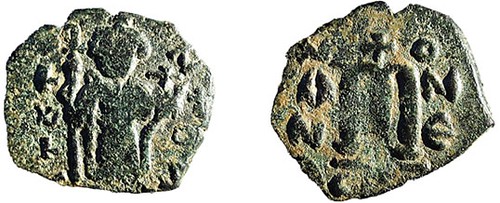
The imperial figure has crosses in his hands and on his crown

On others, however, the crosses were removed.
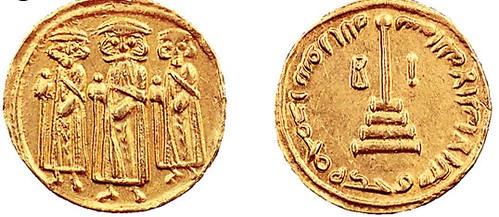
These new gold coins, with their Islamic inscriptions in Arabic, caused an international crisis. Because of a treaty that followed an earlier defeat, ‘Abd al-Malik had been paying tribute to the Byzantines. When, in 692, he tried to pay it with the new coins, Emperor Justinian ii (r. 669-711 ce) refused them because the coins were of a type never seen before. Refusal of the tribute broke the treaty, and war followed.
To read the complete article, see:
Coins of Two Realms
(www.aramcoworld.com/issue/201503/coins.of.two.realms.htm)
THE BOOK BAZARRE
1952 ‘GERMANISCHES MUSEUM’ COMMEMORATIVE COIN
In August 1952, the German National Museum in Nuremberg celebrated its 100th anniversary. The then Federal President Theodor Heuss, in his capacity as Chairman of the Administrative Board of the National Museum, thought that this jubilee would offer a splendid opportunity to show the public, both at home and abroad, that Germany had indeed changed. At the place where the Nazis used to hold their Nuremberg rallies, he celebrated German culture, and demanded in his programmatic opening speech that the city of Nuremberg ought to shake off its bad reputation, which originated in the recent past, and that its intellectual and its artistic life ought to express itself again.
The administration discussed of course supporting measures for this mega event. In a letter dating from July 3, 1952 – rather late, admittedly –, the Bavarian State Ministry of Education and Cultural Affairs pointed out “that the Federation should issue a commemorative coin on the occasion of the centennial, following the example of the world’s cultural states’ best practice. It would be not necessary that the coin would be issued on the day of the jubilee, as it would likewise attract attention, if it was issued in autumn 1952.”
The decision of the Ministry of Finance was issued at the beginning of August so that the artists could then be invited to enter the competition. The date for the jury’s initial meeting had to be postponed a number of times because not every draft had been submitted in time. However, it was as early as October 9, 1952, that the draft of the Munich-based medalist Karl Roth was accepted, due to “the symbolic being concise and the formal being well-balanced and lucid”. It was a top-class jury. It consisted of the director of the German National Museum, the head of the Bavarian State Coin Collection as well as the head of the Bavarian Mint in Munich. The only thing they criticized was the side of the eagle which the artist was obliged to rework, therefore. Karl Roth complied and handed in a new draft which was then accepted unanimously.
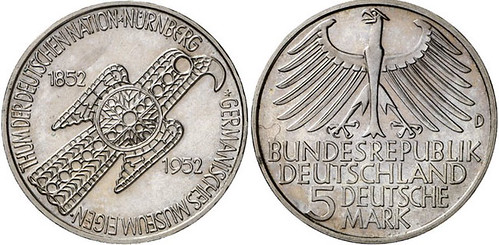
Pattern; Lot 4469
The reverse of the pattern that was not released, of which until now a plaster cast model was the only testimony, is markedly different from the actual coin. It shows the federal eagle and the inscription homogeneously distributed while in the accepted pattern the inscription is a bit unbalanced graphically and makes the eagle become a marginal figure. Since the alternative for the first German commemorative coin has finally shown up, everyone can form his own opinion about the taste of Federal President Theodor Heuss.
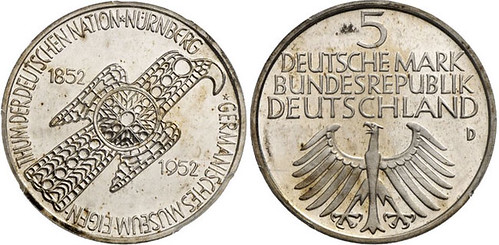
Commemorative coin ‘Germanisches Museum’, as executed.
Of all commemorative coins issued by the Federal Republic of Germany, the ‘Germanic Museum’ is the most expensive one. It is quite hard to get it in a perfect state of preservation. Yet when it does happen, the coin in question easily obtains a price considerably higher than 1,000 euros.
To read the complete article, see:
The True Draft
of the First Commemorative Coin of the Federal Republic of Germany
(news.coinupdate.com/the-true-draft-of-the-first-commemorative-coin-of-the-federal-republic-of-germany-4839/)
DOWNIE'S TO SELL AUSTRALIAN MASTER COINS
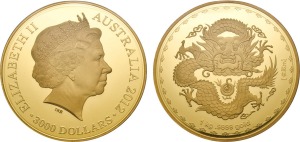 Next Tuesday, 1146 coins from the Royal Australian Mint's Master Collection will be sold through
Downies Australian Coin Auctions at Box Hill Town Hall in Melbourne.
Next Tuesday, 1146 coins from the Royal Australian Mint's Master Collection will be sold through
Downies Australian Coin Auctions at Box Hill Town Hall in Melbourne.
The coins to be sold are known as production standard master coins, used by the mint for quality control during the production of circulating and collectable coins.
Here's how it works. Two coins are hand-picked from the first batch struck of every new series and retained as quality standards. One is kept on the factory floor for checking purposes, then destroyed after five years. The second master is marked in red and placed in the official mint archives. These are the ones that will be sold.
Master coins are not included in the official mintage figures, so some collectors may not even be aware of their existence. It's the first time any have been offered for public or private sale.
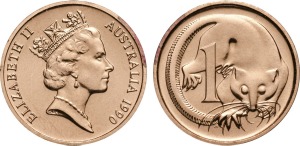 The coins date from 1986 to 2014. Auction estimates range from $25 to $60,000. They are being sold
because the Mint is streamlining the manufacturing process, which includes reducing the number of coins kept in the archives.
The coins date from 1986 to 2014. Auction estimates range from $25 to $60,000. They are being sold
because the Mint is streamlining the manufacturing process, which includes reducing the number of coins kept in the archives.
"This regular review and audit of processes is vital to ensure items are not retained unnecessarily," says Royal Australian Mint chief executive Ross MacDiarmid.
"In effect, these coins are unique," he says. "They are the greatest among their equals."
The highest estimate at the sale is $60,000, for the 2012 Lucky Dragon gold master coin, weighing one kilogram. Its condition is described as proof-like. These coins retailed for about $92,000 at the time. The official mintage figure was 100, with as many as 90 sold.
The lowest pre-sale estimate value is $25, and is how much you could expect to pay for a 1990 one-cent master coin, one of the last required, as Paul Keating decided to delete the smaller denominations soon after. Millions of 1¢ coins were produced, but even the common ones are now gaining modestly in value, selling for 50¢ or more.
To read the complete article, see:
Mint's master sale
has coin collectors excited (www.smh.com.au/money/investing/mints-master-sale-has-coin-collectors-excited-20150514-gh1fgx.html)
THE BEGINNING OF THE END OF CURRENCY AND COINS?
Pabitra Saha writes:
We all know that the demand for coins is decreasing as more and more commerce shifts to electronic payment. Denmark announced outsourcing of its minting and currency printing, recently.
Now it has announced that the shops can refuse notes and coins. It strikes the very basis of definition of "legal tender". Is it the beginning of the end of currency and coins, as we know them?
The Denmark Central Bank, National Banken, will be discontinuing the printing of new fiat in 2016. They will be outsourcing the printing of money to a private business or businesses, this part remains unclear.
Their reasoning for this is because more and more people are using digital payment systems. Such as cards, online payments, third party platforms, and to a minor extent (yes, we are still relatively very small), cryptocurrency. Shop owners can even refuse to accept notes and coins from 2016.
To read the complete article, see:
DENMARK CENTRAL
BANK TO STOP PRINTING MONEY: SHOPS CAN REFUSE TO ACCEPT NOTES AND COINS
(www.cryptocoinsnews.com/denmark-central-bank-stop-printing-money-shops-can-refuse-accept-notes-coins/)
THE BOOK BAZARRE
BEWARE! BOOKS ARE DANGEROUS
It’s no secret that books are dangerous, and that they pose a threat young students. For every student whose life is saved by a book, there are dozens more innocent victims of book-related danger. Books are hazards! They’re flammable! And probably obscene! Wake up, sheeple!
Thankfully, a Canadian school district is finally taking action against books. If they were American, they would just ban books from the school library, but instead they’re banning them from the school bus. CBC News reports:
An eight-year-old girl in St-Jean-sur-Richelieu, Que. was told she’s no longer allowed to read books on the school bus because it poses a risk to the safety of other students.
Sarah Auger loves reading and used to enjoy using her 20-minute ride to and from school to read for pleasure. But recently, her bus driver told her she had to stop.
She says she was told reading posed a risk to other students on the bus. He suggested they might stand up to see what she was reading, or she might poke herself in the eye with the corners of the book.
To read the complete article, see:
School bus driver bans reading, because books
are dangerous (www.mhpbooks.com/school-bus-driver-bans-reading-because-books-are-dangerous/)
FEATURED WEB SITE: THE SILVER STRIKERS CLUB
This week's Featured Web Site is the Silver Strikers Club.What is a Silver Strike?
The definition is Limited Edition silver token won from slot machines and is in a protective plastic holder. Some call them "Silver Premium Tokens", but most of us just call them "Silver Strikes". These tokens are issued in many casinos throughout the United States, Canada, the Caribbean and Cruise Ships. The first of these tokens were won from slot machines in the Reno/Tahoe area of Nevada in 1992.
The tokens have been issued with redeemable values of $2, $3, $5, $7, $10, $12, $20, $28, $40, $200, $300 and range in size from 1-1/2 inches to 3-1/2 inches in diameter depending on the value. The $200 & $300 are the only Silver Strikes to be paid by the attendant, due to its size and weight. The $12 tokens are from cruise ships.
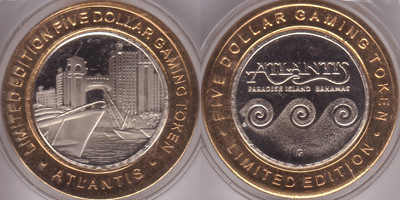
www.silverstrikers.com
